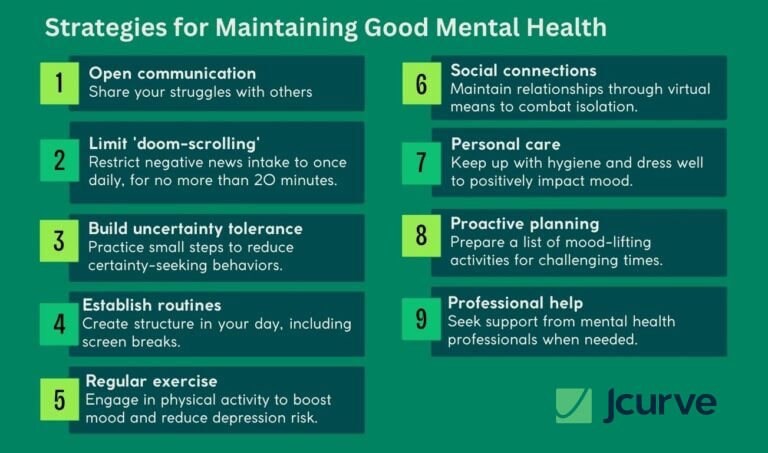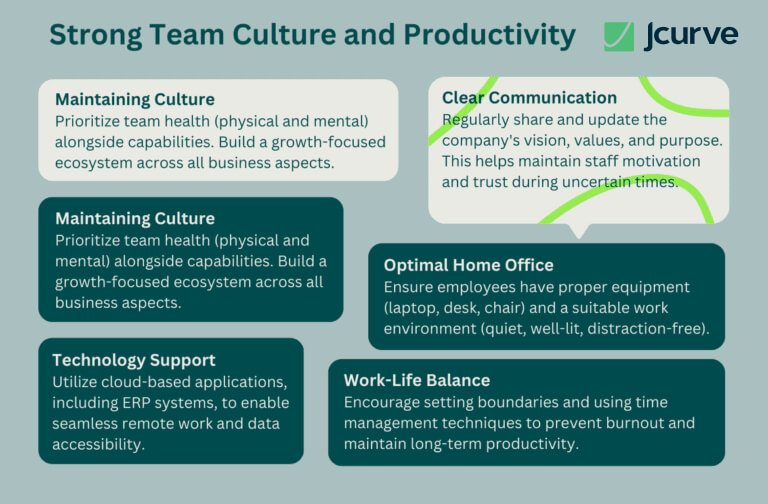
This article discusses how businesses can use Enterprise Resource Planning (ERP) systems to become more resilient after the COVID-19 pandemic. It covers various strategies including improving digital capabilities, focusing on omnichannel approaches, strengthening customer connections, and preparing for economic recovery. The article also addresses the importance of employee wellbeing and mental health in maintaining business resilience.
Increase Your Digital Capability
You may have noticed how many major events are being canceled right now, all across the globe. MWC, the world’s biggest annual trade show for showcasing mobile phone technology, was canceled just a few weeks prior, amid growing coronavirus fears. Leading technology companies have since followed suit. Events such as Google I/O, Facebook F8 and the E3 gaming conference were canceled altogether. Other events such as Adobe Summit and Dell World were reformatted to online-only events, and others still including the Game Developers Conference (GDC) and the IoT World Developer Conference postponed until later in the year.
The tumultuous landscape formed around physical events highlights the need to be digitally-capable. A company that can run web-based events stands a real chance of retaining and expanding its audience – whereas those without experience in the digital events space will need to catch up quickly to stay in the race.
The current contagion fears have also caused face-to-face meetings to all but disappear from sight. As customers shy away from physical meetings, having the tools and know-how to conduct virtual meetings becomes crucial to business continuity.
Increase Your Digital Capability
The coronavirus crisis has significantly impacted retail, especially physical stores. Brands like Harris Scarfe, Jeanswest, and EB Games had already closed locations even before COVID-19 escalated, and others like Kikki.K were hit harder as social distancing caused a decline in foot traffic. Constant sales promotions, like “40-60% off,” reflect retailers’ struggles to adapt to fierce competition, particularly from online shopping.
With 81% of customers starting their buying journey online, global competition is tough, as customers can easily find cheaper options abroad.
To compete, businesses need to enhance the in-store experience and adopt an omnichannel strategy that blends online and physical shopping, such as offering online purchases with in-store returns. Shoppers also value tangible experiences but often end up purchasing from competitors online afterward. Cross-channel promotions can help retain customers, and implementing CRM systems can provide valuable customer insights, enabling personalized service and better recommendations. Overall, developing a strong omni-channel presence and customer relationship management is crucial to stay ahead of global competitors, especially as the economy recovers post-pandemic.
All these data safety measures working together have seen NetSuite consistently meet a 99.98% service up-time to its customers, globally.”
Connect with Your Customers
In times of uncertainty like the coronavirus pandemic, being transparent with customers is crucial. Address their concerns about potential delays or changes in communication formats, such as increased virtual meetings. Ensuring clear and consistent messaging across all channels helps maintain trust. Involve marketing to ensure accuracy and alignment with your brand, and proactively set expectations. Doing so will strengthen customer relationships and foster long-term connections beyond the crisis.
Inefficiencies Hinder Growth
Companies should avoid turning down jobs due to inefficient scheduling and capacity management, which are common with paper or whiteboard systems. These manual processes can hinder growth by creating inefficiencies and obscuring business visibility. Digitizing operations with service management software provides crucial data and enhances visibility, making it easier for non-tech-savvy business owners to streamline their processes. As the post-pandemic economic rebound accelerates, businesses must embrace digitization to stay competitive, eliminate inefficiencies, and deliver superior digital customer experiences.ll businesses to leverage the same technology that larger providers use, making it essential to digitize and optimize the customer experience.
Prepare for the Bounce-Back
Coronavirus has hit the economy hard – both locally and internationally – and it’s a perfect storm for which recovery efforts may take considerable time. The knock-on effects from the virus have already taken their toll on global economic growth with manufacturing seeing its worst contraction since 2009. Business confidence indexes across major economies have plummeted. Global stock markets have seen trillions of dollars wiped. New cases of coronavirus, however, have slowed dramatically in China – and that’s a positive sign that COVID-19 may have hit its speed limit. The coronavirus crisis “off-ramp” is approaching, and it’s time to plan your next route.
What can you learn from other economies that have already seen the worst of the crisis? How can you support your employees in working from home if and when they need to? Is business continuity already a standard or could you stand to become more digitally-capable with a stronger omnichannel strategy? Have you built the right foundations with customers through proactive communication to weather the storm together?
Now is the time to identify the opportunities, get strategic, and prepare for the positive bounce-back when the worst of COVID-19 is over. It’s also time to create your own story around business continuity, and take control of the narrative. With the right preparation, it may end up being your business growth that surges faster than expected.
What Used to Work May Not Always Work
How businesses operate today has dramatically changed from 12-18 months ago and now is a time for reflection. Rather than doing what has always been done, businesses need to ask themselves some key questions.
Was there a need to pivot as a business or a team? Were there any changes made that supercharged the business’ productivity or success? What key initiatives should be kept in place for the future?
In truth, no one knows if it is the right move for businesses to invest in technology or ramp up expansion plans in the current climate. However, the key here does not lie in the leap of faith – it lies in the process. A progressive business should continue refining its digital journey by reflecting, pivoting, and adapting, instead of simply jumping on the bandwagon.
Taking Next Steps to Success
To drive business expansion, it’s crucial to build an ecosystem that encourages workforce reskilling. In Singapore, for example, the Infocomm Media Development Authority (IMDA) launched the TechSkills Accelerator (TeSA) initiative to support hiring and training for tech roles, which also aids in providing training and digital tools where needed.
Professional services-based businesses can tap into growing tech talent pools in regions like Southeast Asia, Eastern Europe, and South America to diversify their teams and strengthen long-term growth plans. As businesses shift operations online due to the pandemic, technology skills remain essential.
To stay competitive, partnering with firms that can help analyze data and improve decision-making is key to driving profitability and exploring new opportunities. Despite physical challenges, the digital world opens avenues for sharing ideas, technology, and talent across regions, allowing businesses to grow sustainably and remain resilient to future disruptions.
To What Extent is the Pandemic Influencing Both Application Modernization and Cloud Migration?
Arthur Fernandez: Since the start of COVID-19, companies experiencing a slowdown in business have taken the opportunity to review and update their business-IT strategy.
With many companies forced to pivot, this situation has opened opportunities to enhance their systems beyond a ‘technical upgrade’ to meet evolving requirements.
According to IDC‘s 2020 APEJ Enterprise Services Sourcing Survey, most companies across the region indicated plans to increase spending on legacy application modernization initiatives – an optimistic outlook in the coming years.
Global Pandemic Spotlights the Importance of Wellbeing
There are several issues that plague employee wellbeing, including always-on technologies fueling 24/7 work expectations and heightening levels of stress. The Singapore Government has even issued a tripartite advisory on mental wellbeing at workplaces, outlining practical guidance on measures that employers can adopt to support their employees’ mental wellbeing. A more recent Study on Future Workplaces by the Monetary Authority of Singapore found that adopting technologies to streamline operations can allow employees to focus more on their wellbeing and increase work flexibility, helping industries prepare for the next pandemic.
With this in mind, businesses have redirected focus and resources to improving employee experience (EX) at home and at work. COVID-19 has shown leaders that there are many compelling business reasons to commit fully to employee wellbeing. For example, higher EX may translate to higher customer experience (CX), which in turn affects upsell and cross-sell potential. Marketing efforts can be heavily supplemented through employee advocacy, especially on social media platforms. Human resources teams have refocused on team building exercises, regular catch-ups, and ensuring flexible feedback channels, especially in relation to remote work.
Managing Mental Health for Business Resilience
If you are feeling your mental health has taken a hit due to COVID, you are not alone. A survey of 5,070 Australian adults was conducted by the University of New South Wales and the Black Dog Institute to assess the mental health impacts of COVID Sixty-two percent of respondents had raised levels of depression, 50 percent had raised levels of anxiety, and 64 percent had raised levels of stress. The effects of COVID on mental health are real and need to be respected.
Why Do We Worry?
Our brains have evolved over thousands of years to keep us safe and as a result they are very good at focusing on danger. Hence, we can easily become addicted to reading news about COVID and overly focus on the negatives. In addition, research has shown that humans tend to exaggerate the danger of an unfamiliar threat (such as COVID) compared to ones we are familiar with such as the flu or car crashes. The result can be anxiety, depression, insomnia and PTSD.
Strategies for Maintaining Good Mental Health

Anxiety Management Technique
- Apply Carl Jung’s principle: “What you resist persists.”
- Instead of fighting anxiety, allow it to be present without judgment.
- Observe and describe anxiety objectively, as if studying it scientifically.
- This approach can help anxiety dissipate naturally.
Leadership and Values in Times of Crisis
Survive or dive will be based on your leadership during this pandemic. Below are several leadership models and strategies that may trigger ideas of how you lead during a pandemic – select the one that you resonate with or seems applicable.
Future-Focused
Leadership
- Envision how you want to be remembered in three years
- List your ideal leadership actions and review regularly
Future-Focused
Leadership
- Schedule regular updates with staff, customers, and suppliers
- Provide clear avenues for questions and concerns
- Check on mental health and prevent burnout
Future-Focused
Leadership
- Remain flexible in operations but steadfast in values
- Communicate commitment to quality and service
Inspire Innovation
- Challenge team to find new ways to add value
- Encourage creative thinking to overcome challenges
Balance Seriousness
with Positivity
- Address concerns while allowing for moments of fun
- Foster a supportive environment to boost morale
Ensure Understanding
- Clearly communicate necessary changes
- Verify that staff comprehend new directions
Cultivating a Healthy Team and Work Environment
The vast migration to remote working has threatened to weaken the solid team culture that companies build. The pandemic has influenced employees’ perceptions of culture, both positively and negatively, and leaders are urged to address these concerns.

All these data safety measures working together have seen NetSuite consistently meet a 99.98% service up-time to its customers, globally.”
Analyze What’s Already Happened
Other countries, such as China, have been impacted more immediately – and are several months in front of other nations in the Asia-Pacific region, and other parts of the world. As explained further in a recent article from Harvard Business Review, China already appears to be seeing the early stages of an economic rebound. Some notable actions that Chinese companies swiftly took during the coronavirus crisis included:
Reallocation of resources. Employees are the lifeblood of the organization and have a wealth of knowledge and experience about the business. Instead of laying off valuable resources, many companies chose to relocate them to recovery planning and strategic, forward-looking activities.
Clever use of social media. With physical store visits declining and customers staying indoors, Cosmo Lady, a Chinese lingerie company, chose to divert promotional efforts to social media channels. The company cleverly leveraged the social connections of its employees to bump up sales. Employees used channels such as WeChat to promote the company’s products and became part of a company-wide sales ranking initiative to motivate staff to participate.
Strong, top-down management focused on keeping employees informed on a regular, timely basis. Early media reports about COVID-19 in China contained confusing and often contradictory information. Several Chinese companies, however, implemented specific operational guidelines and instructions on preventative measures and emergency plans. Those companies’ top-level management quickly disseminated updates and information to staff to keep uncertainty and worry minimized.
Coronavirus has hit the economy hard – both locally and internationally – and it’s a perfect storm for which recovery efforts may take considerable time. The knock-on effects from the virus have already taken their toll on global economic growth with manufacturing seeing its worst contraction since 2009
Phy-gital Roadblocks Ahead
There are key barriers that can hinder business transformation if not addressed properly. Internally, finding the right people willing to grow with the company is challenging, especially in labor-intensive industries like manufacturing, retail, and wholesale distribution, where employees need to upskill and adapt to remote or digital operations. Many employees may resist changing roles or exploring new areas due to economic uncertainty.
Externally, selecting the right vendor or partner is crucial, especially as businesses rapidly adopt digital solutions. A trusted technology provider is essential to improve cloud infrastructure and meet evolving digital needs. Both internal talent development and external partnerships are interconnected in driving successful business transformation.
Benefits that an ERP offers to an organization
- Enhanced Digital Capability: ERP systems enable businesses to conduct virtual meetings, manage remote work, and run web-based events, crucial for business continuity in a digital-first world.
- Improved Omnichannel Strategy: ERP helps integrate online and physical shopping experiences, providing a unified view of customer data across all channels.
- Increased Operational Efficiency: By digitizing operations, ERP eliminates inefficiencies in scheduling and capacity management, enhancing overall business visibility.
- Data-Driven Decision Making: ERP provides real-time analytics and reporting capabilities, crucial for navigating uncertain times.
- Strengthened Supply Chain Management: ERP offers real-time visibility into inventory levels and supplier performance, crucial for managing supply chain disruptions.
- Support for Remote Work: Cloud-based ERP solutions enable seamless access to critical business data and processes from anywhere, supporting flexible work arrangements.
Conclusion
To succeed in the post-pandemic business world, companies need to embrace digital transformation, prioritize customer experience, and support employee wellbeing. By leveraging ERP systems and other digital tools, businesses can streamline operations, improve decision-making, and adapt to changing market conditions. As the economy recovers, those who have invested in these areas will be better positioned to thrive in the new business landscape.
It’s crucial for leaders to maintain clear communication, uphold company values, and foster a healthy team culture to ensure long-term success and resilience. Implementing the right technology solutions is a key step in this process. JCurve Solutions offers comprehensive ERP and business management systems that can help your organization navigate these challenges and emerge stronger in the post-pandemic era. By partnering with experienced providers like JCurve, businesses can access the tools and expertise needed to build a resilient, adaptable, and successful operation in today’s dynamic business environment.
In an attempt to seek answers on how organizations can adopt a healthier team culture, HR in Asia invites Stephen Canning, Chief Executive Officer at Jcurve to share his point of view.
Q1. Prolonged Covid-19 outbreak has already had a marked effect on people’s mental health. Stephen, how do you find yourself coping with the relentless pandemic? What are your strategies to combat fatigue and stress?
Answer: COVID-19 has had a devastating impact across the globe, with all of us having to deal with the constant threat to our health, our families, and our businesses. Having been largely denied our usual coping mechanisms such as socializing, traveling, and dining out, this has led to a lot of emotional exhaustion.
The pandemic is no different than any other stressor except in one important way: it is relentless. So, I deal with it by being relentless in pursuing my coping strategies:
Staying healthy. I cycle, I swim, and yes, I even had dumbbells delivered home. I’ve also always loved cooking and eating at home seven days a week allows me to fully control my diet. When you make all your own meals, you know exactly what ingredients go in. No excuses!
Staying informed. Like my food diet, I watch my news diet and limit where I get my information from to just a handful of trusted sources.
Staying in touch with friends and family through technology. While it is not the same as the real thing, social connection is now more important than ever.
Q2. More than half of employees globally report higher levels of work-related stress while working from home, driven by increased workloads and changes to working patterns. Do you notice a similar trend among your employees? If yes, what has your organization done to address the issue?
Answer: I have noticed a tendency for some of us, myself included, to convert our former commute time into work time, increasing our working hours almost without noticing. At Jcurve, maintaining a healthy work-life balance while working from home is something that we regularly talk to our employees about. After all, if your manager cannot physically see you, it can be challenging to know how many hours an employee is working.
We also give our employees a high degree of flexibility in the hours they work. For example, an employee may send out an email in the evening because they have been dealing with childcare during the day. We have worked hard with all employees to ensure that we recognize and respect the working patterns of others. Just because technology allows employees to be contacted at any time, does not mean they should be.
Q3. Recent WHO report highlights a shortfall in investment in mental health. Among the reason cited is lack of leadership and governance. In your opinion, what can businesses do better to support their workforce’s mental health?
Answer: Businesses can better support their workforce’s mental health by having robust policies in place. Exactly what the policy looks like will vary between businesses; it could be as simple as ensuring employees take all their annual leave allowances or operating a no-emails policy in the evenings or at weekends.
Regardless, the policy needs to be created collaboratively with employees, and it needs to be clearly communicated to ensure no communication gaps. Supporting mental health and wellbeing in the long run is not only good for the workforce, but also for the growth of the business through better employee engagement, performance, and staff retention.
Q4. Based on your observation, how are businesses in Singapore doing in cultivating healthy team cultures as compared to other countries across the Asia Pacific?
Answer: Building a healthy team culture is core to everything that we do at Jcurve. Why? Because it is a differentiator. A healthy culture leads to highly engaged employees, which leads to the delivery of an excellent customer experience (CX).
Let’s take CX maturity as a proxy for cultural health. Customer experience performance in Singapore saw an improvement in excellence rating in 2020 by 7% compared to 2019, according to a KPMG study. While this is a healthy level, there is clearly room for improvement as we head into 2022.
Q5. A survey reveals that most CEOs (96 percent) thought their companies were doing enough to promote mental health. But, interestingly, only 69 percent of workers felt their employers were adequately addressing workplace mental health. How can such a perception gap happen?
Answer: I believe that a large portion of that gap is a communications gap. Many companies put a policy in place, tell their staff and tick the box – but people management is never as simple as ‘plug and play’. Businesses need to do more to remind employees of the initiatives or policies available to promote mental health. People only retain information that they believe is relevant to them and would most likely not remember when they actually need help or support months later. In progressive workplaces, information is readily available, and employers make it a point to remind teams of such access, and then remind them again.
Q6. Mental health apps have shown effectiveness in decreasing symptoms of depression and anxiety. Given this opportunity, how can employers utilize data and technology to increase employee wellbeing?
Answer: Employers should focus on preventative care by encouraging employees to take a proactive approach to all aspects of their health. So many of us are already using technology to monitor our activity, such as sleep and fitness trackers, telehealth apps to monitor our diet and visit a virtual general practitioner, as well as social media and online forums to discuss health issues. We are already comfortable using technology to improve our health, and it is up to an employer to actively encourage that.
For example, at Jcurve, we hold virtual fitness week challenges and regular virtual yoga events to encourage healthy work-life balance and promote a positive outlook.
Q7. What are simple steps businesses can do to start building a healthier culture? What aspects should be taken into consideration?
Answer: Here are simple steps to start building a healthier culture:
- Build trust with your employees. That means always doing what you say you are going to do, being fair, respectful, and inclusive.
- Treat staff as individuals; there is no one size fits all. Invest in their learning and development.
- Make it easy for staff. Take away the friction points and have a bias toward action.
- Listen to staff, seek their feedback, and put yourself in their shoes.
- Meet and exceed your staff’s expectations. Go above and beyond just as you would for your customers.
- Take ownership of mistakes. Employers get it wrong sometimes. Own it and fix it.

Jessica has a Bachelor of Arts degree from Trent University and a Masters degree from Cambridge University. He is an Adjunct Professor of Finance at Simon Fraser University’s Beedie School of Business and is both a Canadian Chartered Professional Accountant and a UK Chartered Accountant.

Jessica has a Bachelor of Arts degree from Trent University and a Masters degree from Cambridge University. He is an Adjunct Professor of Finance at Simon Fraser University’s Beedie School of Business and is both a Canadian Chartered Professional Accountant and a UK Chartered Accountant.





